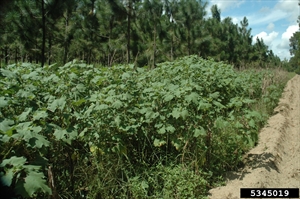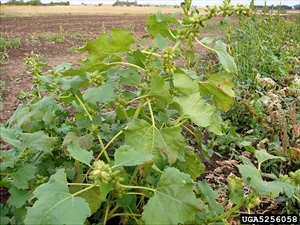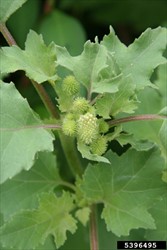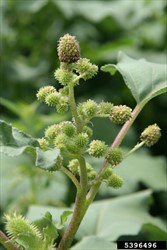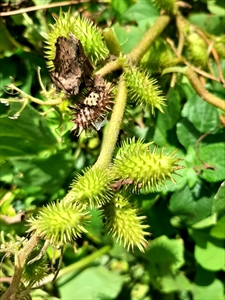Noogoora burr; it is also known as cockleburr, or common cockleburr.
Pacific Pests, Pathogens and Weeds - Online edition
Pacific Pests, Pathogens & Weeds
Noogoora burr (471)
Xanthium strumarium. It is also known as Xanthium pungens and Xanthium occidentale. It is a member of the Asteraceae.
Asia, Africa, North America, the Caribbean (restricted), Europe, Oceania. It is recorded from Australia, Fiji, New Zealand, and Papua New Guinea.
Origin uncertain; possibly Central America.
A weed forming large stands on disturbed land, such as along roadsides, in drainage ditches, on savannahs, water courses, floodplains, dry sandy riverbeds and on wasteland, in temperate, semi-arid, sub-tropical and tropical environments (Photo 1). Also, a weed of row crops, plantations, pastures. Invasive weediness is associated with tolerance to a range of soil types, climates, as well as ease of transfer between different regions of the world.
Annual weed, with erect, multi-branching stems, 20-150 cm tall, with short dark streaks or dots, and short, stiff hairs (Photo 2). Leaves, vary along stem - lower opposite, upper alternate - up to 20 cm long, dark green on the upper surface, triangular to egg-shaped, margins irregularly toothed, surfaces rough with tiny bristles, leaf stalks up to 12 cm long (Photo 3).
Separate male and female flower heads, arising from leaf axils towards the end of the branches (Photos 4-6). The male flowers are mostly in clusters towards the top of the branches whereas the female flowers are in clusters lower down. The female flowers are in burrs that have hooked spines; the males flowers are in burrs without hooked spines. The fruits are brown, hard, woody, 1.2–2 cm long, containing two seeds. Seeds are grey or black, 4–5 mm long and 5–7 mm wide (Photo 7). They are flattened on one side, and one seed of each pair is usually slightly larger than the other (Photo 8).
Spread is assisted by the hooked spines of the burrs, which readily become attached to animals, clothing, and vehicles, They may also spread in water, and in materials used for road maintenance.
A major weed of economic importance in row crops: soybeans, cotton, maize and groundnuts in North America, southern Europe, the Middle East, South Africa, India and Japan. In the USA, yield losses in soybean are up to 16% with 0.5 noogoora burr plants per metre row, rising to 80% if there are over 10 per metre row. Losses in peanuts were greater. In Italy, not only were there losses from competition, but also from the presence of foreign material derived from the burr during harvest.
In Australia, a further economic impact comes from the invasions of pastures. The burrs contaminate sheep's wool, reduce quality and increase the costs of processing. Thick patches of the burr may prevent sheep and other animals accessing watering points. Furthermore, seedlings are reported to be poisonous to livestock if eaten in large quantities in Australia.
The environmental impact of the weed comes from its ability to form dense stands and out-compete native plants.
It has been used for making a yellow dye. It is a Chinese medicine for nasal and sinus congestion.
BIOSECURITY
The risk of introduction is high. Countries not yet infested should consider all likely pathways for entry, and apply quarantine measures accordingly. Particular attention should be given to the risks associated with its seeds that are easily spread.
BIOCONTROL
Several insects and fungi have been investigated, and releases made, but results so far have not been successful. The moths, Euaresta aequalis, from the USA and Epiblema strenuana from Mexico, and beetles, Mecas saturnina and Nupserha vexator (from the USA), were introduced to Australia. The rust fungus, Puccinia xanthii (accidentally) introduced into Australia was not sufficiently specific to noogoora burr.
CULTURAL CONTROL
- Physical & Mechanical:
- Hand weeding. Pull-up plants before flowering and burr formation. Not an option for large stands because of the labour involved. Hoeing is also a useful method for controlling small areas of the weed.
- Cultivation. Useful for seedlings. Inter-row cultivation is used commonly in sorghum, corn and cotton.
- Slashing or mowing. Probably best when followed up with herbicide treatment as there is the potential for buds to grow from the base if roots and stem have not been severed.
- Hygiene:
- Treat vehicles and farm machinery. If moving from areas where the weed occurs to those weed-free, wash to remove soil. This is equally important if the machinery is being imported into a country or moved within a country.
- Ensure seeds are not carried on clothes between infested and 'clean' areas.
CHEMICAL CONTROL
In Australia, the following herbicides are registered: 2,4-D (amine & ester); 2,4-D + picloram; glyphosate (and Fiji); fluroxpyr; metsulfuron-methyl; MCPA.
--------------------
Note, EU approval to use glyphosate ends in December 2022; its use after that date is under discussion.
____________________
When using a pesticide, always wear protective clothing and follow the instructions on the product label, such as dosage, timing of application, and pre-harvest interval. Recommendations will vary with the crop and system of cultivation. Expert advice on the most appropriate herbicides to use should always be sought from local agricultural authorities.
AUTHORS Grahame Jackson, Aradhana Deesh & Mani Mua
Adapted from Noogoora burr (Xanthium occidentale) (2018) Weeds of SE Qld and Northern NSW. Lucidcentral. (https://www.lucidcentral.org/editors-pick-animal-and-plant-identification-keys/key-to-weeds-of-se-qld-and-northern-nsw); and additional information from CABI (2019) Xanthium strumarium (common cockleburr). Invasive Species Compendium. (https://www.cabi.org/isc/datasheet/56864); and Noogoora burr Xanthium pungens (2020) Department of Agriculture and Fisheries. The State of Queensland. (https://www.daf.qld.gov.au/__data/assets/pdf_file/0008/77723/IPA-Noogoora-Burr-PP17.pdf); and from Xanthium strumarium L. (2016) Weeds of Australia. Biosecurity Queensland Edition. Queensland Government. (https://keyserver.lucidcentral.org/weeds/data/media/Html/xanthium_strumarium.htm). Photo 1 David J. Moorhead, University of Georgia, Bugwood.org. Photo 2 Jan Samanek, Phytosanitary Administration, Bugwood.org. Photo 3-5 Robert Vidéki, Doronicum Kft., Bugwood.org. Photo 7 Bruce Ackley, The Ohio State University, Bugwood.org.
Produced with support from the Australian Centre for International Agricultural Research under project HORT/2016/185: Responding to emerging pest and disease threats to horticulture in the Pacific islands, implemented by the University of Queensland, in association with the Pacific Community and Koronivia Research Station, Ministry of Agriculture, Fiji.
